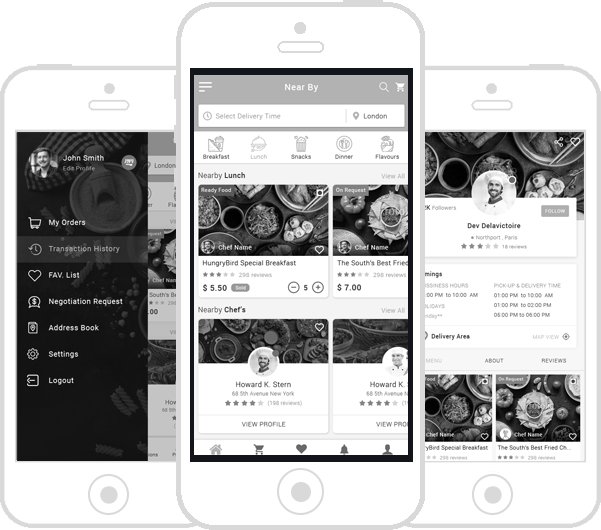1. The Top Dropshipping Apps for Online Retailers
The success of your e-commerce venture depends on your choice of the top dropshipping applications. These programs automate inventory management and order fulfillment, freeing you up to concentrate on marketing and customer support. Well-liked choices include Printful, Oberlo, and Spocket; each provides special capabilities to satisfy a range of corporate requirements.
Key Features
- Easy-to-use UI for effortless navigation
- The flexibility to source products from a variety of vendors
- Real-time inventory updates to prevent stockouts
- The platform integrates with well-known e-commerce sites such as WooCommerce and Shopify


2. Best E-commerce Platforms for Dropshipping
Choosing the appropriate e-commerce platform is crucial for the success of dropshipping. The best e-commerce App Development platforms allow you to effectively manage your online store by seamlessly integrating with different dropshipping apps. Among the top choices are Shopify, WooCommerce, and BigCommerce, each of which can accommodate varying business needs and sizes.
Key Features
- Usability and setup simplicity
- Payment gateway options are available to make life easier for customers
- Personalized elements for branding
- Scalability allows your company to grow with you
3. Comparisons and Reviews of Dropshipping Apps
Review and comparison shopping is a beneficial idea before deciding on a dropshipping app. App Developers India proves These insights assist in determining the advantages and disadvantages of different apps, helping you make the optimal decision for your business plan. Comprehensive reviews are available on websites like G2 and Capterra, which help you make an informed choice.
Key Features
- Consumer opinions regarding support and usability
- Pricing schemes and additional costs
- Performance indicators for dependability and speed
- Ensure compatibility with the tools you already own


4. Low-Cost Dropshipping Options for Online Retailers
Starting an internet business doesn't have to be expensive. There are numerous reasonably priced dropshipping options that provide the necessary resources without charging exorbitant monthly fees. Platforms like SaleHoo or AliDropship allow you to find affordable options with useful features for managing your business.
Key Features
- To reduce financial risk, there is a minimal initial outlay
- Plans with variable pricing to fit different budgets
- Access to a wide variety of products for different markets is crucial
- Tools for low-cost marketing that increase traffic are available
5. E-commerce Dropshipping Software and Tools
E-commerce dropshipping software and tools aim to enhance productivity and streamline processes. These solutions help business owners save time and simplify activities, from order administration to customer interactions. Popular solutions, such as Oberlo for product sourcing and AfterShip for shipment tracking, are available to make dropshipping easier to handle.
Key Features
- Systems for managing inventories to prevent stock shortages
- Email marketing software to engage customers
- Tools for analytics to track performance
- Chatbots for automated client support


6. How to Select Dropshipping Apps for Business
Choosing the best dropshipping applications can have a big impact on your online store. Begin by evaluating your unique requirements, including your target market and product line. You can obtain clarity by contrasting features and reading user feedback. Take into account the level of customer service and the possibilities for system integration with your current setup.
Key Features
- Determine the needs and goals of your business
- Examine the features and costs of various apps
- Verify it works with your e-commerce platform by reading customer reviews
7. User-Friendly Dropshipping E-commerce Applications
Easy-to-use dropshipping e-commerce applications are critical for a flawless experience. Apps with an emphasis on intuitive design make navigation easier, lower the learning curve, and free up your time so you can concentrate on expanding your company. Platforms like Shopify and Wix offer simple interfaces that make store management easy.
Key Features
- Drag-and-drop interface for simple website creation
- Clear instructions and tutorials for novice users
- Mobile-friendly features for management on the go
- Quick-response customer service to help with problems


8. Websites That Integrate E-commerce and Dropshipping
Your e-commerce website must integrate dropshipping for smooth operations. Numerous e-commerce platforms provide plugins and APIs to enable seamless integration with dropshipping apps and guarantee real-time synchronization of product listings, orders, and inventories. This relationship improves the customer experience and reduces errors.
Key Features
- Time-saving order processing through simplification
- Automated inventory updates to minimize labor-intensive tasks
- A unified dashboard for managing each sales channel
- Improved client relations with linked tools
9. Characteristics of Successful Dropshipping Applications
Successful dropshipping apps design their features to meet the requirements of online retailers. These features, which range from powerful product sourcing to analytics capabilities, can greatly improve your dropshipping experience. Knowing these features can help you choose an app that supports your company's objectives.
Key Features
- Time-saving automated order fulfillment
- Management of suppliers for efficient sourcing
- Sales analytics to track growth and performance
- Customizable product listings for branding


10. Tips for Improving the E-commerce Experience with Dropshipping
It takes a combination of smart tactics and appropriate resources to maximize your e-commerce dropshipping experience. Prioritize delivering top-notch customer service, making decisions with data analytics, and continuously improving your product line. Maintaining flexibility and responsiveness to market developments will help you improve the performance of your company.
Key Features
- Continually check product listings for accuracy
- Use social media marketing to draw clients
- Employ SEO best practices to gain more exposure
- Track client feedback to improve service
list of Dropshipping E-commerce Apps
| App Name | Key Features |
|---|---|
| Printful | Print-on-demand services, custom branding, wide product range |
| Oberlo | Product sourcing, easy Shopify integration, real-time inventory updates |
| Spocket | Access to US/EU suppliers, fast shipping, branded invoicing |
| SaleHoo | Directory of suppliers, market research tools, community support |
| AliDropship | AliExpress integration, customizable online stores, one-time fee |
| AfterShip | Shipment tracking, automated notifications, branded tracking page |
| Modalyst | Curated product selection, fast shipping, automated inventory management |
| Dropified | Product importing, order fulfillment automation, multiple platform support |
| Wholesale2B | Access to multiple suppliers, easy integration, inventory management |
| Printify | Custom products, wide range of suppliers, easy integration with major platforms |
Seller Screens for Dropshipping E-commerce Apps
| Screen Name | Features | Explanation |
|---|---|---|
| Login/Registration |
|
This screen allows users to create an account or log in to their existing account, providing various authentication methods for convenience. |
| Dashboard |
|
The dashboard provides a summary of the user’s business performance, including total sales, recent orders, and shortcuts to important features. |
| Product Catalog |
|
This screen displays all available products for dropshipping, allowing users to search, filter, and add products directly to their store. |
| Order Management |
|
Users can manage their orders by viewing past orders, tracking current shipments, and processing returns or cancellations. |
| Customer Management |
|
This screen allows users to view and manage customer information, including communication history and data analytics for better targeting. |
| Analytics and Reports |
|
Users can generate various reports to analyze sales performance, website traffic, and overall business metrics for informed decision-making. |
| Settings |
|
This screen allows users to manage their account settings, including updating personal information, payment methods, and shipping preferences. |
| Support |
|
The support screen provides users with access to help resources, a way to contact support, and live chat for immediate assistance. |
Buyer Screens for Dropshipping E-commerce Apps
| Screen Name | Features | Explanation |
|---|---|---|
| Home Screen |
|
This screen showcases popular and featured products, along with any ongoing promotions, providing a user-friendly navigation menu for easy access to other sections. |
| Product Listings |
|
Users can browse through product listings with options to search, filter, and sort items based on various criteria, enhancing the shopping experience. |
| Product Details |
|
This screen provides detailed information about a specific product, including images, descriptions, specifications, and user reviews to aid in purchase decisions. |
| Shopping Cart |
|
Users can review items in their cart, modify quantities, or remove products, along with viewing the estimated total cost before proceeding to checkout. |
| Checkout |
|
This screen allows users to input their billing and shipping details, select a payment method, and review the order summary before finalizing the purchase. |
| Order Confirmation |
|
After completing a purchase, users receive an order confirmation displaying the order details, estimated delivery date, and a link to track their order status. |
| Account Profile |
|
This screen allows users to manage their account details, view past orders, and update their payment information for future purchases. |
| Wishlist |
|
Users can save products to a wishlist for later consideration, share their wishlist with others, and receive notifications if prices drop on desired items. |
| Support |
|
The support screen provides users access to frequently asked questions, options to contact customer support, and live chat for immediate help. |
Estimated Cost Breakdown Dropshipping E-commerce Apps
| Cost Category | Estimated Cost (USD) | Description |
|---|---|---|
| E-commerce Platform Subscription | $29 - $299/month | Fees for platforms like Shopify, WooCommerce, or BigCommerce based on the plan you choose. |
| Domain Name Registration | $10 - $20/year | The cost of registering a unique domain name for your online store. |
| Website Hosting | $5 - $50/month | Monthly fees for hosting your e-commerce site, particularly relevant for self-hosted solutions like WooCommerce. |
| Dropshipping App Subscription | $0 - $100/month | Fees for using dropshipping apps like Oberlo, Spocket, or Printful, depending on features and usage. |
| Payment Gateway Fees | 2% - 3% per transaction | Fees charged by payment processors like PayPal or Stripe on each sale. |
| Marketing and Advertising | $100 - $1,000+/month | Costs for online marketing, including social media ads, SEO, and email marketing. |
| Design and Development | $500 - $5,000 | Initial costs for designing and developing your app or website, including custom features. |
| Customer Support Tools | $10 - $200/month | Costs for tools like chatbots or helpdesk software to manage customer inquiries. |
| Maintenance and Updates | $50 - $500/month | Regular maintenance costs, including software updates and technical support. |
FAQs
1. What is dropshipping?
Dropshipping is a retail fulfillment method where a store doesn't keep the products it sells in stock. Instead, when you sell a product, you purchase the item from a third party and have it shipped directly to the customer.
2. How does a dropshipping business model work?
In dropshipping, the retailer partners with suppliers who manage inventory and shipping. The retailer focuses on marketing and sales, while suppliers handle fulfillment.
3. What are the benefits of dropshipping?
Benefits include low startup costs, a wide product selection, no inventory management, and flexibility in location since you can run the business from anywhere with an internet connection.
4. What are the challenges of dropshipping?
Challenges include low profit margins, reliance on suppliers for inventory and shipping, potential shipping delays, and difficulty in managing customer service.
5. Do I need a business license to start dropshipping?
Depending on your location, you may need a business license or sales tax permit. It's best to check local regulations to ensure compliance.
6. How do I choose a niche for my dropshipping business?
Choose a niche based on market research, trends, competition analysis, and your interests or expertise. Focus on a niche with sufficient demand and manageable competition.
7. What platforms can I use for dropshipping?
You can use platforms like Shopify, WooCommerce, BigCommerce, and Magento, which offer easy integration with dropshipping apps.
8. How do I find suppliers for my dropshipping business?
Suppliers can be found through dropshipping platforms like Oberlo, Spocket, SaleHoo, or by searching directories and marketplaces like Alibaba and AliExpress.
9. What is the typical profit margin in dropshipping?
Profit margins in dropshipping typically range from 10% to 30%, depending on the products, supplier costs, and pricing strategies.
10. How do I handle returns and refunds?
Return and refund policies should be clearly outlined on your website. Work with suppliers to understand their return policies and communicate with customers effectively.
11. Can I automate my dropshipping business?
Yes, many dropshipping apps and tools allow you to automate processes like order fulfillment, inventory management, and customer communications.
12. How do I market my dropshipping store?
You can use social media marketing, search engine optimization (SEO), email marketing, content marketing, and paid advertising to promote your dropshipping store.
13. What payment methods should I offer?
Offer multiple payment methods like credit/debit cards, PayPal, and other digital wallets to cater to customer preferences.
14. How do I set competitive prices?
Research competitors' pricing, consider your costs, and use pricing strategies like keystone markup or psychological pricing to attract customers.
15. Is dropshipping a viable long-term business model?
While dropshipping can be profitable, it requires ongoing effort in marketing, customer service, and finding reliable suppliers to sustain long-term success.
16. How do I build customer trust?
Build trust by having a professional-looking website, offering clear return policies, providing excellent customer service, and showcasing customer reviews and testimonials.
17. Can I run a dropshipping business part-time?
Yes, many entrepreneurs start dropshipping as a side business. However, time management and commitment are essential for growth.
18. How do I keep track of my orders?
Use order management tools or software that integrates with your e-commerce platform to streamline order tracking and fulfillment.
19. What are the legal considerations in dropshipping?
Ensure compliance with local laws, including sales tax collection, consumer protection regulations, and intellectual property rights when selecting products.
20. How do I scale my dropshipping business?
Scale your business by expanding your product range, improving marketing efforts, optimizing operations, and exploring new sales channels.
Your choice of weapon
Build your Apps for any Platform
We to code. It's our passion










you can also reach us at our given
email address or phone number.







